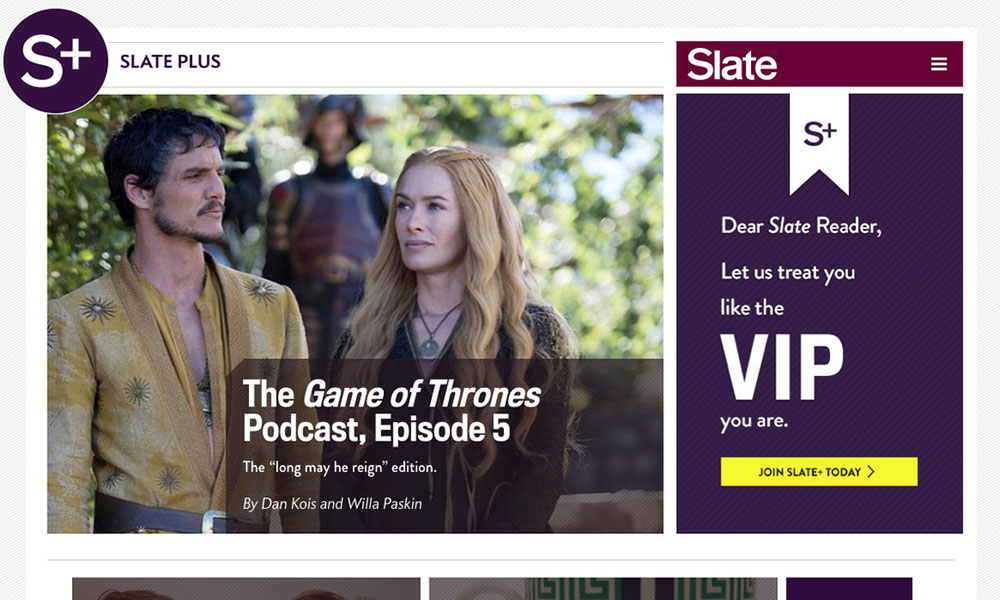
What Slate Might Learn From Associations
So you want to launch a membership program for your most avid readers? Associations have a little experience with that. Here's some advice.
Have you ever loved a magazine, newspaper, or website so much that you wanted to take that relationship to the next level? To no longer be just a subscriber, but a member? Well, if you’re a fan of Slate, you’re in luck.
As Ernie Smith shared here in late March, the online magazine Slate has launched a membership program dubbed Slate Plus. For me, this news felt like worlds colliding. I’ve been reading Slate more or less daily for years—it’s one of a handful of browser tabs I keep open 24/7 on my iPad—and membership as a topic makes up a significant portion of my day job. But I’ll admit that my first reaction to Slate launching a membership program was, in so many words, “huh?”
Like my fellow association professionals, I view membership as belonging to a group, because associations are, in essence, groups of people with common interests and goals. When I join an association, sure, I get plenty of stuff, but I also join a community of people I can relate to. And in the best circumstances, joining an association says something important about how you identify yourself.
Slate Plus will be a fascinating experiment for anyone interested in membership or media business models.
But do the readers of an online magazine fit that mold? Until now, I’ve never thought so, and I’m still not sure I do. In all the time I’ve been reading Slate, I’ve never really wondered about who else was reading it, aside from people I already know in real life. And as much as I like it, I’m not sure I reach fanboy status. To put my money where my mouth is, though, I joined Slate Plus this week, and I’ll be eager to see what the member experience is like.
In any case, Slate Plus will be a fascinating experiment for anyone interested in membership or media business models, and the folks there at least deserve praise for trying something new in the quest for new revenue streams. While a lot of other media sites have tried paywalls or meters in recent years , Slate has purposefully shaped its pay option as a membership program, joining National Journal and Talking Points Memo as one of the few who have tried it. Slate editor David Plotz tried to make this clear in his description of the program: “So, what is Slate Plus? First, let me say what it’s not. It’s not a paywall. Let me say that again: It’s not a paywall!”
It may ultimately be unfair to compare Slate Plus with membership in a trade association or professional society, but let’s assume for a moment that Slate really does want to build a community with this membership program—that it wants to build something a bit association-like. Here’s my advice to make Slate Plus a genuine community for Slate readers to belong to:
Connect Slate Plus members with each other. Do this online and, better yet, do it in person. When you host events for readers to hear from Slate staff in person, build in time for Slate Plus members to meet and get to know each other. Foster the social interactions that lead to emotional bonds, because that’s the stuff that will keep people around year after year.
Strive to understand members’ motivations for joining, and then use that knowledge. Are people joining for the access to Slate writers, discounts on events, or single-page articles? Or maybe it’s the behind-the-scenes content, the member discussions, or the free coffee mug. Or, just maybe, they’re altruistic souls who simply believe in the power of good journalism. Don’t assume it’s all of the above. Most members will join for one or two reasons, and you should seek to know what those are for each member. Then you can tailor your benefits both in aggregate and on an individual basis.
Define what it means to be a Slate Plus member. This goes back to the idea that joining a group says something about who you are. So what does joining Slate Plus say about me? You can fill in some of this definition according to the type of people you want to attract, but an equal portion of it should arise from what you observe (see previous step) about your members as they build in number and you continue to interact with them.
Give members a voice, and make them feel heard. Comments and discussions are a nice start, but those can be a jungle. The member takeover series is fun, too. But part of what binds an association member community is its participatory, democratic nature. Members write for association publications. They lead educational sessions at their conferences. They serve on myriad committees and taskforces that collaborate on industry-wide projects. And they serve on boards of directors that guide the direction of their associations. You’ve expressed a desire to “involve [members] in shaping Slate‘s future.” Don’t let that just be lipservice. A Slate Plus “member of the week,” member guest writers, and editorial advisory board would all be easy ways for members to influence—and, importantly, see how they’re influencing—the publication they’re dedicated to.
What’s your mission? Maybe this is where the gap between publication and association is too wide, but it’s worth thinking about. The basic reason every trade association and professional society exists is to promote the success of its members’ pursuits—and, often, by extension, to make the world a better place (e.g., if a medical association helps doctors learn better care, then their patients are better cared for). And ASAE research shows good-of-the-order benefits are just as important as personal benefits in a member’s decision to join. So, why does Slate exist? (Other than to make money for Graham Holdings Company.) If you want members to join, to hand over their money and time to support Slate, you have to give them something to believe in.
Dedicate resources to managing the Slate Plus community. You’re already doing this, with membership editors Jennifer Lai and Jeff Friedrich. They have their work cut out for them, but they’ll serve a vital role to the program’s success.
Again, a publication and an association might be too dissimilar for these ideas to work beyond their original context. But, to be fair, associations have plenty of members who are little more than subscribers, and we’ve drawn lessons from publications’ paid-content models in this space before.
Slate Plus, though, is one of the first major publications—and likely the biggest yet—that we’ve seen attempt a membership model, and membership is associations’ bread and butter. So, my fellow association professionals, while we usually offer advice to each other in this space, here’s a chance to share your expertise with someone outside our community. You all run membership programs at your associations, so what’s your advice for Slate to make Slate Plus succeed? Please share in the comments.






Comments